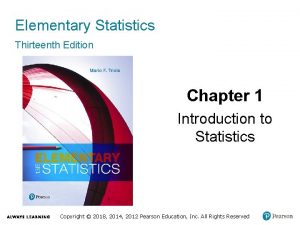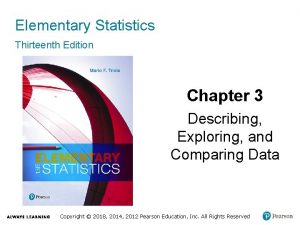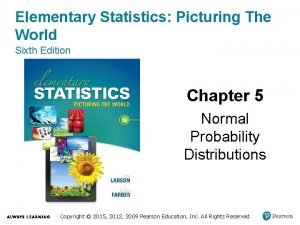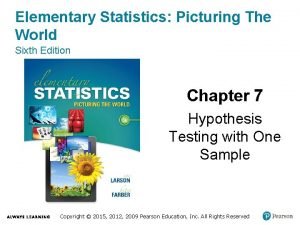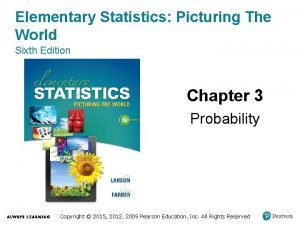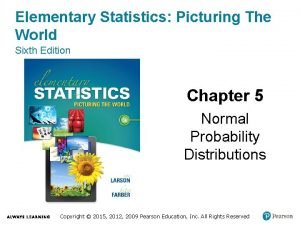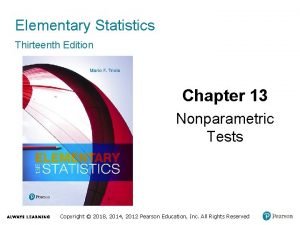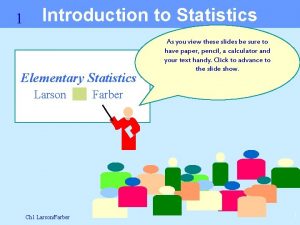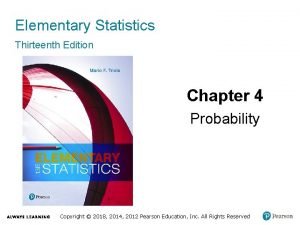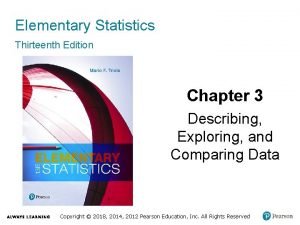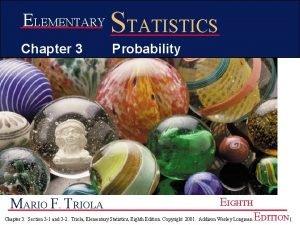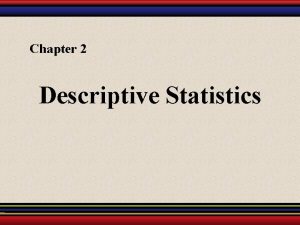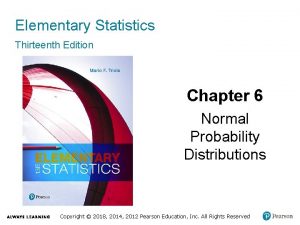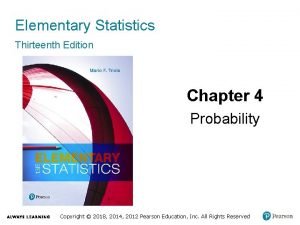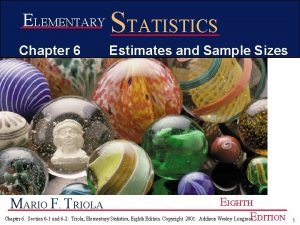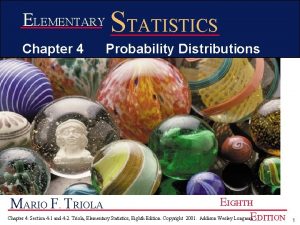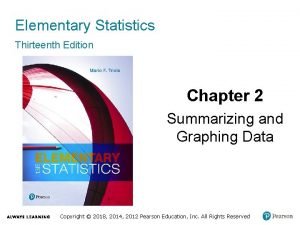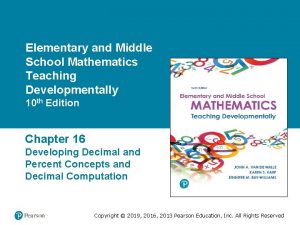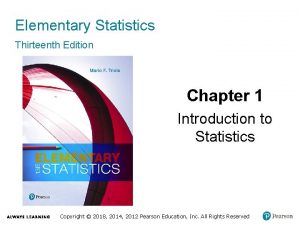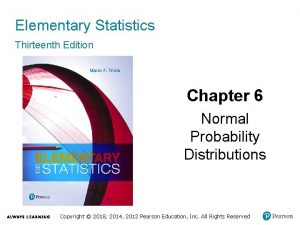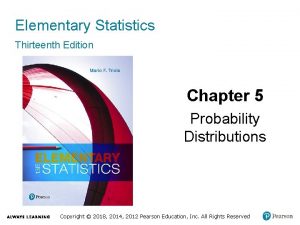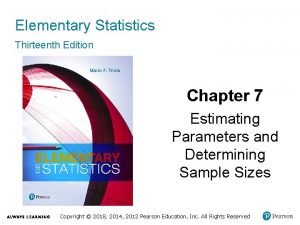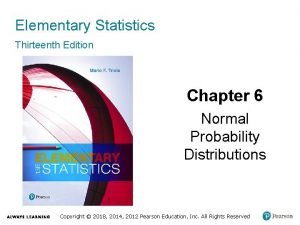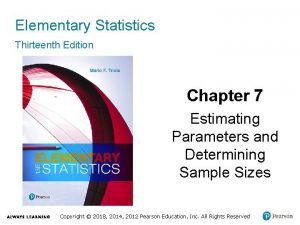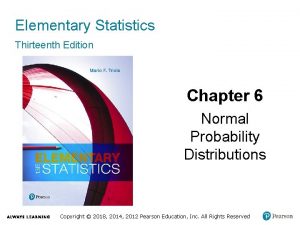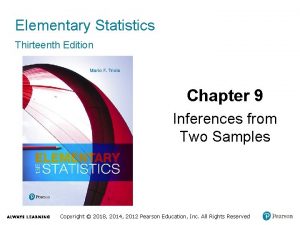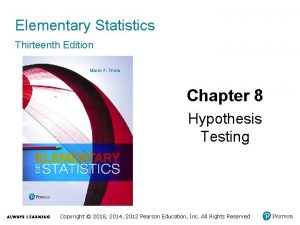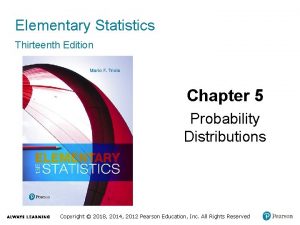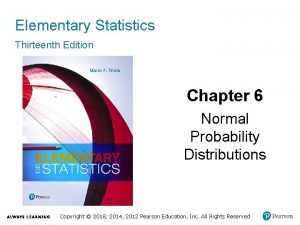Elementary Statistics Thirteenth Edition Chapter 1 Introduction to



















- Slides: 19

Elementary Statistics Thirteenth Edition Chapter 1 Introduction to Statistics Copyright © 2018, 2014, 2012 Pearson Education, Inc. All Rights Reserved

Introduction to Statistics 1 -1 Statistical and Critical Thinking 1 -2 Types of Data 1 -3 Collecting Sample Data Copyright © 2018, 2014, 2012 Pearson Education, Inc. All Rights Reserved

Key Concept A major use of statistics is to collect and use sample data to make conclusions about populations. Copyright © 2018, 2014, 2012 Pearson Education, Inc. All Rights Reserved

Parameter • Parameter – a numerical measurement describing some characteristic of a population Copyright © 2018, 2014, 2012 Pearson Education, Inc. All Rights Reserved

Statistic • Statistic – a numerical measurement describing some characteristic of a sample Copyright © 2018, 2014, 2012 Pearson Education, Inc. All Rights Reserved

Quantitative Data • Quantitative (or numerical) data – consists of numbers representing counts or measurements. Example: The weights of supermodels Example: The ages of respondents Copyright © 2018, 2014, 2012 Pearson Education, Inc. All Rights Reserved

Categorical Data • Categorical (or qualitative or attribute) data – consists of names or labels (not numbers that represent counts or measurements). Example: The gender (male/female) of professional athletes Example: Shirt numbers on professional athletes uniforms - substitutes for names Copyright © 2018, 2014, 2012 Pearson Education, Inc. All Rights Reserved

Working with Quantitative Data Quantitative data can be further described by distinguishing between discrete and continuous types. Copyright © 2018, 2014, 2012 Pearson Education, Inc. All Rights Reserved

Discrete Data • Discrete data – result when the data values are quantitative and the number of values is finite, or “countable. ” Example: The number of tosses of a coin before getting tails Copyright © 2018, 2014, 2012 Pearson Education, Inc. All Rights Reserved

Continuous Data • Continuous (numerical) data – result from infinitely many possible quantitative values, where the collection of values is not countable. Example: The lengths of distances from 0 cm to 12 cm Copyright © 2018, 2014, 2012 Pearson Education, Inc. All Rights Reserved

Levels of Measurement • Another way of classifying data is to use four levels of measurement: nominal, ordinal, interval, and ratio. Copyright © 2018, 2014, 2012 Pearson Education, Inc. All Rights Reserved

Nominal Level • Nominal level of measurement – characterized by data that consist of names, labels, or categories only, and the data cannot be arranged in some order (such as low to high). Example: Survey responses of yes, no, and undecided Copyright © 2018, 2014, 2012 Pearson Education, Inc. All Rights Reserved

Ordinal Level • Ordinal level of measurement – involves data that can be arranged in some order, but differences (obtained by subtraction) between data values either cannot be determined or are meaningless. Example: Course grades A, B, C, D, or F Copyright © 2018, 2014, 2012 Pearson Education, Inc. All Rights Reserved

Interval Level • Interval level of measurement – involves data that can be arranged in order, and the differences between data values can be found are meaningful. However, there is no natural zero starting point at which none of the quantity is present. Example: Years 1000, 2000, 1776, and 1492 Copyright © 2018, 2014, 2012 Pearson Education, Inc. All Rights Reserved

Ratio Level • Ratio level of measurement – data can be arranged in order, differences can be found are meaningful, and there is a natural zero starting point (where zero indicates that none of the quantity is present). Differences and ratios are both meaningful. Example: Class times of 50 minutes and 100 minutes Copyright © 2018, 2014, 2012 Pearson Education, Inc. All Rights Reserved

Summary - Levels of Measurement • Nominal - categories only • Ordinal - categories with some order • Interval - differences but no natural zero point • Ratio - differences and a natural zero point Copyright © 2018, 2014, 2012 Pearson Education, Inc. All Rights Reserved

Big Data • Big data – refers to data sets so large and so complex that their analysis is beyond the capabilities of traditional software tools. Analysis of big data may require software simultaneously running in parallel on many different computers. • Data science – involves applications of statistics, computer science, and software engineering, along with some other relevant fields (such as sociology or finance). Copyright © 2018, 2014, 2012 Pearson Education, Inc. All Rights Reserved

Missing Data • A data value is missing completely at random if the likelihood of its being missing is independent of its value or any of the other values in the data set. That is, any data value is just as likely to be missing as any other data value. • A data value is missing not at random if the missing value is related to the reason that it is missing. Copyright © 2018, 2014, 2012 Pearson Education, Inc. All Rights Reserved

Correcting for Missing Data 1. Delete Cases: One very common method for dealing with missing data is to delete all subjects having any missing values. 2. Impute Missing Values: We “impute” missing data values when we substitute values for them. Copyright © 2018, 2014, 2012 Pearson Education, Inc. All Rights Reserved
 Elementary statistics 13th edition chapter 1
Elementary statistics 13th edition chapter 1 Elementary statistics 13th edition answers
Elementary statistics 13th edition answers Elementary statistics 6th edition
Elementary statistics 6th edition Elementary statistics 6th edition
Elementary statistics 6th edition Elementary statistics picturing the world 6th edition
Elementary statistics picturing the world 6th edition Elementary statistics tenth edition
Elementary statistics tenth edition Elementary statistics picturing the world 6th edition
Elementary statistics picturing the world 6th edition Elementary statistics 13th edition
Elementary statistics 13th edition Introduction to elementary statistics
Introduction to elementary statistics Introduction to statistics what is statistics
Introduction to statistics what is statistics 5% guideline for cumbersome calculations
5% guideline for cumbersome calculations Elementary statistics chapter 3
Elementary statistics chapter 3 What will be the probability of an impossible event
What will be the probability of an impossible event Class mark in statistics
Class mark in statistics Elementary statistics chapter 6
Elementary statistics chapter 6 Elementary statistics chapter 4
Elementary statistics chapter 4 Margin of error
Margin of error Elementary statistics chapter 4
Elementary statistics chapter 4 Elementary statistics chapter 2
Elementary statistics chapter 2 Elementary and middle school mathematics 10th edition
Elementary and middle school mathematics 10th edition
